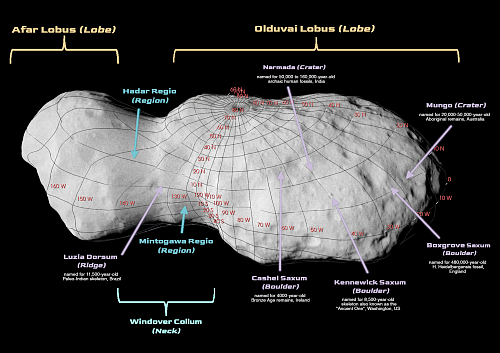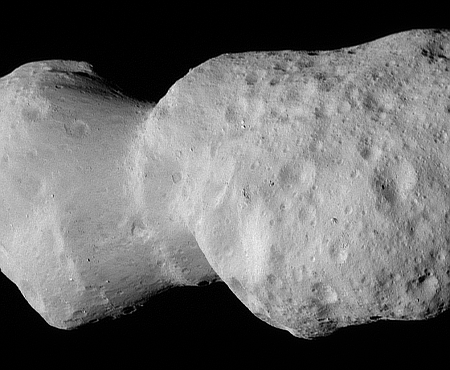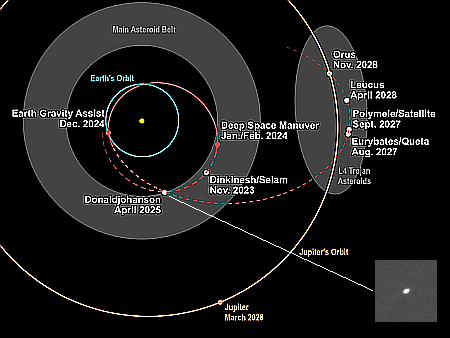Lucy scientists name the features on asteroid Donaldjohanson
The science team for the asteroid probe Lucy have now released their names for the features they discovered on the main belt asteroid Donaldjohanson when the spacecraft flew past in April 2025.
The smaller lobe is called Afar Lobus, after the Ethiopian region where Lucy and other hominin fossils were found. The larger lobe is named Olduvai Lobus, after the Tanzanian river gorge that has also yielded many important hominin discoveries.
The asteroid’s neck, Windover Collum, which joins those two lobes, is named after the Windover Archeological Site near Cape Canaveral Space Force Station in Florida — where NASA’s Lucy mission launched in 2021. Human remains and artifacts recovered from that site revolutionized our understanding of the people who lived in Florida around 7,300 years ago.
Two smooth areas on the asteroid’s neck are named Hadar Regio, marking the specific site of Johanson’s discovery of the Lucy fossil, and Minatogawa Regio, after the location where the oldest known hominins in Japan were found. Select boulders and craters on Donaldjohanson are named after notable fossils ranging from pre-Homo sapiens hominins to ancient modern humans.
These names were “approved” by the International Astronautical Union (IAU), which claims the authority over the naming of every rock, boulder, pebble in space. The truth is, however, that future spacefarers are going to accept these names no matter what the IAU had said, simply because these scientists did the first exploration of this asteroid. They get to choose, not the IAU.
The spacecraft is now on its long coast out of the main belt and on to the orbit of Jupiter, where it will make fly-bys of ten different asteroids.
The science team for the asteroid probe Lucy have now released their names for the features they discovered on the main belt asteroid Donaldjohanson when the spacecraft flew past in April 2025.
The smaller lobe is called Afar Lobus, after the Ethiopian region where Lucy and other hominin fossils were found. The larger lobe is named Olduvai Lobus, after the Tanzanian river gorge that has also yielded many important hominin discoveries.
The asteroid’s neck, Windover Collum, which joins those two lobes, is named after the Windover Archeological Site near Cape Canaveral Space Force Station in Florida — where NASA’s Lucy mission launched in 2021. Human remains and artifacts recovered from that site revolutionized our understanding of the people who lived in Florida around 7,300 years ago.
Two smooth areas on the asteroid’s neck are named Hadar Regio, marking the specific site of Johanson’s discovery of the Lucy fossil, and Minatogawa Regio, after the location where the oldest known hominins in Japan were found. Select boulders and craters on Donaldjohanson are named after notable fossils ranging from pre-Homo sapiens hominins to ancient modern humans.
These names were “approved” by the International Astronautical Union (IAU), which claims the authority over the naming of every rock, boulder, pebble in space. The truth is, however, that future spacefarers are going to accept these names no matter what the IAU had said, simply because these scientists did the first exploration of this asteroid. They get to choose, not the IAU.
The spacecraft is now on its long coast out of the main belt and on to the orbit of Jupiter, where it will make fly-bys of ten different asteroids.



